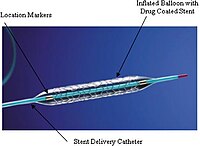
Development and Characterization of PLGA-Based Multistage Delivery System for Enhanced Payload Delivery to Targeted Vascular Endothelium.
Sign Up to like & getrecommendations! Published in 2021 at "Macromolecular bioscience"
DOI: 10.1002/mabi.202000377
Abstract: Vascular-targeted drug delivery remains an attractive platform for therapeutic and diagnostic interventions in human diseases. This work focuses on the development of a poly-lactic-co-glycolic-acid (PLGA)-based multistage delivery system (MDS). MDS consists of two stages: a… read more here.
Keywords: based multistage; delivery; plga based; mds ... See more keywords

QbD enabled optimization of solvent shifting method for fabrication of PLGA-based nanoparticles for promising delivery of Capecitabine for antitumor activity.
Sign Up to like & getrecommendations! Published in 2021 at "Drug delivery and translational research"
DOI: 10.1007/s13346-021-01042-0
Abstract: The key objective of the current research was to fabricate and optimize Capecitabine (Cap)-loaded [poly(lactic-co-glycolic acid)] PLGA-based nanoparticles (NPs) by enabling quality by design (QbD) approach for enhancing antitumor activity by promising delivery of the… read more here.
Keywords: based nanoparticles; antitumor activity; drug; promising delivery ... See more keywords

Recent Advances in PLGA-based Biomaterials for Bone Tissue Regeneration.
Sign Up to like & getrecommendations! Published in 2021 at "Acta biomaterialia"
DOI: 10.1016/j.actbio.2021.03.067
Abstract: Bone regeneration is an interdisciplinary complex lesson, including but not limited to materials science, biomechanics, immunology, and biology. Having witnessed impressive progress in the past decades in the development of bone substitutes; however, it must… read more here.
Keywords: bone tissue; regeneration; bone; recent advances ... See more keywords

A mechanistic model for drug release from PLGA-based drug eluting stent: A computational study
Sign Up to like & getrecommendations! Published in 2017 at "Computers in biology and medicine"
DOI: 10.1016/j.compbiomed.2017.09.001
Abstract: Atherosclerosis in the coronary artery is one of the leading causes of death in the world. The stenting as a minimally invasive technique was considered as an effective tool to reduce the severity of atherosclerotic… read more here.
Keywords: drug eluting; coronary artery; drug; drug release ... See more keywords

PLGA-based monolithic filaments prepared by hot-melt extrusion: In-vitro comparative study.
Sign Up to like & getrecommendations! Published in 2018 at "Annales pharmaceutiques francaises"
DOI: 10.1016/j.pharma.2017.09.002
Abstract: To avoid frequent drug administration, PLGA-based monolithic filament-shaped implants were prepared. In this study, the effect of different formulation variables was studied, namely: type of PLGA (PLGA 502 and PLGA 503), type of drug (the… read more here.
Keywords: based monolithic; drug; drug release; prepared hot ... See more keywords

Terbinafine-loaded branched PLGA-based cationic nanoparticles with modifiable properties
Sign Up to like & getrecommendations! Published in 2019 at "Pharmaceutical Development and Technology"
DOI: 10.1080/10837450.2019.1667387
Abstract: Abstract Although the systemic administration of terbinafine is quite well tolerated, topical treatment of the local infections is often preferred. New formulation strategies in topical antifungal therapy represent the polymeric nanoparticles (NPs). We successfully employed… read more here.
Keywords: branched plga; based cationic; terbinafine; plga based ... See more keywords

Current trends in PLGA based long-acting injectable products: The industry perspective
Sign Up to like & getrecommendations! Published in 2022 at "Expert Opinion on Drug Delivery"
DOI: 10.1080/17425247.2022.2075845
Abstract: ABSTRACT Introduction Poly(lactic-co-glycolic acid) (PLGA) has been used in many long-acting drug formulations, which have been approved by the US Food and Drug Administration (FDA). PLGA has unique physicochemical properties, which results in complexities in… read more here.
Keywords: plga based; current trends; based long; development ... See more keywords

Exploiting PLGA-Based Biocompatible Nanoparticles for Next-Generation Tolerogenic Vaccines against Autoimmune Disease
Sign Up to like & getrecommendations! Published in 2019 at "International Journal of Molecular Sciences"
DOI: 10.3390/ijms20010204
Abstract: Tolerogenic vaccines are aimed at inhibiting antigen-specific immune responses. Antigen-loaded nanoparticles (NPs) have been recently emerged as ideal tools for tolerogenic vaccination because their composition, size, and capability of loading immunomodulatory molecules can be readily… read more here.
Keywords: biocompatible nanoparticles; exploiting plga; plga nps; based biocompatible ... See more keywords

PLGA-Based Composites for Various Biomedical Applications
Sign Up to like & getrecommendations! Published in 2022 at "International Journal of Molecular Sciences"
DOI: 10.3390/ijms23042034
Abstract: Polymeric materials have been extensively explored in the field of nanomedicine; within them, poly lactic-co-glycolic acid (PLGA) holds a prominent position in micro- and nanotechnology due to its biocompatibility and controllable biodegradability. In this review… read more here.
Keywords: plga based; based composites; biomedical applications; various biomedical ... See more keywords

Application of 3D-Printed, PLGA-Based Scaffolds in Bone Tissue Engineering
Sign Up to like & getrecommendations! Published in 2022 at "International Journal of Molecular Sciences"
DOI: 10.3390/ijms23105831
Abstract: Polylactic acid–glycolic acid (PLGA) has been widely used in bone tissue engineering due to its favorable biocompatibility and adjustable biodegradation. 3D printing technology can prepare scaffolds with rich structure and function, and is one of… read more here.
Keywords: bone tissue; plga based; tissue engineering; scaffolds bone ... See more keywords

Recent Advances in the Surface Functionalization of PLGA-Based Nanomedicines
Sign Up to like & getrecommendations! Published in 2022 at "Nanomaterials"
DOI: 10.3390/nano12030354
Abstract: Therapeutics are habitually characterized by short plasma half-lives and little affinity for targeted cells. To overcome these challenges, nanoparticulate systems have entered into the disease arena. Poly(d,l-lactide-co-glycolide) (PLGA) is one of the most relevant biocompatible… read more here.
Keywords: plga based; plga; based nanomedicines; functionalization ... See more keywords